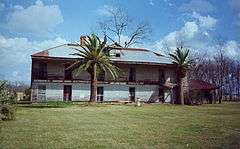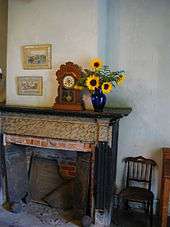Laura Plantation
|
Laura Plantation | |
|
Laura Plantation house in 2011 after restoration | |
  | |
| Nearest city | Vacherie, Louisiana |
|---|---|
| Area | 37 acres (15 ha) |
| Built | 1805 |
| Architectural style | Stick/eastlake, Other, French Creole |
| MPS | Louisiana's French Creole architecture MPS |
| NRHP Reference # | 92001842[1] |
| Added to NRHP | February 3, 1993 |

Laura Plantation is a restored historic Louisiana Creole plantation on the west bank of the Mississippi River near Vacherie, Louisiana, (U.S.), open for guided tours.[2] Formerly known as Duparc Plantation, it is significant for its early 19th-century Créole-style raised big house and several surviving outbuildings, including six slave cabins. It is one of only 15 plantation complexes in Louisiana with this many complete structures.[2] Because of its historical importance, the plantation is on the National Register of Historic Places. The site, in St. James Parish, Louisiana, is also included on the Louisiana African American Heritage Trail.
Alcée Fortier, who later became Professor of Romance Languages and folklore at Tulane University, was said to have collected Louisiana Creole versions of the West African Br'er Rabbit stories here in the 1870s.
The parents and family of U.S. singer-songwriter Fats Domino ("Blueberry Hill") had lived on the plantation.
History
In the early 1700s, a large Colapissa village called Tabiscanja or "long river view" was located on high ground above the Mississippi River. In 1785, Acadian refugees settled on the site.[3]
In 1804, the Frenchman Guillaume Duparc, a naval veteran from the American Revolutionary War, had petitioned then-President Thomas Jefferson, for land.[4] Jefferson secured Duparc's loyalty to the U.S., which had just acquired additional territory through the Louisiana Purchase, by granting him land along the Mississippi River. Considering the natives to be Frenchmen, the French did not force them off the riverlands. Instead, the Colapissa continued to live on the rear part of the plantation until 1915.
Duparc Plantation built his plantation house during 1804 and 1805. The house had a U-shape, with the two back wings around a central courtyard, and a detached kitchen building in the back. The Duparc family acquired adjacent parcels of land, and the sugarcane plantation was expanded to over 12,000 acres (5,000 ha) of real estate. The plantation size, wings of the manor house, and outbuildings have changed over the years from the original plantation house completed in 1805.
The sugar mill was located in the distance, 1 mile (1.6 km) behind the big house, surrounded by sugarcane fields. A longer dirt road extended behind the house for 3.5 miles (6 km), lined with the slave cabins to house the workers.
In the years before the American Civil War, the slave quarters included a slave infirmary, 69 cabins, communal kitchens, and several water wells located along the road. Each slave cabin was occupied by two families, as duplex units sharing a central double fireplace. Near each cabin was a vegetable garden plus a chicken coop and/or pigpen.[5] By the time of the Civil War there were 186 slaves working the farm. The DuParc Plantation exported indigo, rice, pecans, and sugar cane.[6]

The complex continued functioning as a plantation into the 20th century. The two back wings of the manor house were removed, widening the back balcony, and a back kitchen wing was added off the back porch. The remaining plantation complex consists of the "big house" with several outbuildings, including six original slave quarters, and a maison de reprise (a second house or mother-in-law cottage). The existence of the slave quarters, which workers continued to live in until 1977, contributes to the historic significance of the complex. Because of its importance, it has been listed on the U.S. National Register of Historic Places. It is used to interpret history and for heritage tourism.
Architecture

Shaded by the low branches of large oak trees, the main house is almost hidden from the road. Constructed in 1804-1805, the "big house" at Laura Plantation has a raised brick basement story and a briquette-entre-poteaux (brick between posts) upper floor.[2] Much of the house was pre-fabricated, as its wooden beams were pre-cut off-site and arrived ready to be installed.[5] It is one of only 30 substantial Créole raised houses in the state.
Also noteworthy are the Federal-style interior woodwork and Norman roof truss, unusual for later Créole houses.[2] The floor plan consists of two rows of five rooms that all open directly into each other without any hallways. The interior of the "big house" is furnished with original antiques. Some pieces were donated to the plantation by families of the original owners. Owners have left some areas inside the home unrestored to give visitors a sense of history and show wall-construction methods.
A large collection of family treasures and some items of apparel are on display, giving a sense of daily life. Laura Locoul Gore's memoir, Memories of the Old Plantation Home, provided much of what is known about life on Laura Plantation. There is a gift shop which has displayed some books about the area and related subjects.
Fire of 2004

On August 9, 2004, the plantation house was significantly damaged by an electrical fire which destroyed 80% of the house,[7] including the kitchen wing behind the house. The left half of the house survived, but even the elevated foundation of the right side was burned. Restoration work was completed in 2006, despite the interruption of Hurricane Katrina in August 2005. The ashes of the kitchen wing were cleared, but the back wing was not rebuilt. Instead, the back corners of the house were capped with old gray boards to indicate where 2 back wings of the house had existed when Laura Lacoul sold the plantation in 1891.[3]
Residents
Guillaume Benjamin Demézière Duparc was at the plantation for only 4 years, dying in 1808, just 3 years after the house was built. The Duparc daughter, Elisabeth, married into the Locoul family, and generations later, Laura Locoul Gore inherited the plantation after moving to New Orleans. Laura's memoirs were published in 2000.[8]
On October 25, 1821, Elisabeth Duparc, a native of Pointe Coupée and the daughter of the late Guillaume Benjamin Demézière Duparc and Anne Nanette Prudhomme, was married at the St. John the Baptist Catholic Church in Edgard to George Raymond Locoul, a native of Bordeaux, France, the son of Raymond Locoul and Marie Roland. From this marriage, the lands of Duparc, which is presently represented by Laura Plantation at the river, became the property of the Locouls. One member, Marie Elisabeth Aimée Locoul, the widow of Jean Flavien Charles de Lobel Mahy, the granddaughter of Guillaume Duparc, subdivided the Duparc tract from the river to Molaison. –Elton J. Oubre, Vacherie, St. James Parish, Louisiana[9]
Laura Locoul Gore was the fourth mistress of the plantation. She was born in the house in 1861. She inherited it and ran it as a sugar business until 1891, when she sold the plantation to Aubert Florian Waguespack. The Waguespack family ran, resided on, and lived at the plantation until 1984.
Laura Plantation's association with the Br'er Rabbit tales drew preservationist Norman Marmillion's attention to the site. He created a for-profit company that attracted enough investors to embark on a ten-year plan of restoration.[10] Some investors are descendants of former owners.
The Brer Rabbit and Br'er Fox tales are variations on traditional stories that originated in Senegal and were brought to America around the 1720s by enslaved Africans. According to the plantation's history, Alcée Fortier, a neighbor of the family and student of folklore, came there in the 1870s to listen to the freedmen. He collected the stories which freedmen told their children in Louisiana Créole French language. These stories were about Compair Lapin and Compair Bouki (the clever rabbit and stupid fool), in which the rabbit plays a trickster role. Twenty-five years later in 1894, Fortier published stories which he had collected and translated in the edition Louisiana Folk Tales: In French Dialect and English Translation. Fortier published such a book and may have collected the tales at Laura Plantation and his own family's plantation.[11]
References
- ↑ National Park Service (2010-07-09). "National Register Information System". National Register of Historic Places. National Park Service.
- 1 2 3 4 "Laura Plantation", National Park Service, 2008, accessed 15 December 2011.
- 1 2 Laura, a Creole plantation
- ↑ "The Duparc Sugar Plantation", Lauraplantation.com, 2008, web:LPsug. Archived December 1, 2011, at the Wayback Machine.
- 1 2 Ray, Derek. "Laura Plantation, Louisiana", San Diego Reader, May 21, 2011
- ↑ "Laura Plantation", The Cultural Landscape Foundation
- ↑ "Laura Plantation - 5 Centuries of Habitation", Lauraplantation.com, 2008 (accessed 15 December 2011), webpage: LP6.
- ↑ Gore, Laura Lacoul (2000). Memories of the Old Plantation Home: A Creole Family Album. The Zoe Co. ISBN 978-0970559104.
- ↑ Quotation from Vacherie, St. James Parish, Louisiana: History and Genealogy by Elton J. Oubre, 1986.
- ↑ Speakman, Stephanie. "World of the Bayou And the Plantation", The New York Times, September 20, 1998
- ↑ Grace Elizabeth King, "Alcée Fortier", Créole Families of New Orleans - Google Book Search, New York: Macmillan & Co., 1921, p.465
- Sources
- Speakman, Stephanie (September 20, 1998). World of the Bayou and the Plantation.
- Taylor, Delia (August 10, 1993). The Greater Baton Rouge Business Report.
External links
| Wikimedia Commons has media related to Laura Plantation. |
- LauraPlantation.com
- The Cultural Landscape Foundation/Laura Plantation
- Reid, Molly. "Creole Country: Laura Plantation Rises From the Ashes", The Times-Picayune, August 15, 2007
Coordinates: 30°00′31″N 90°43′31″W / 30.008730°N 90.725328°W